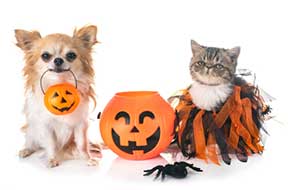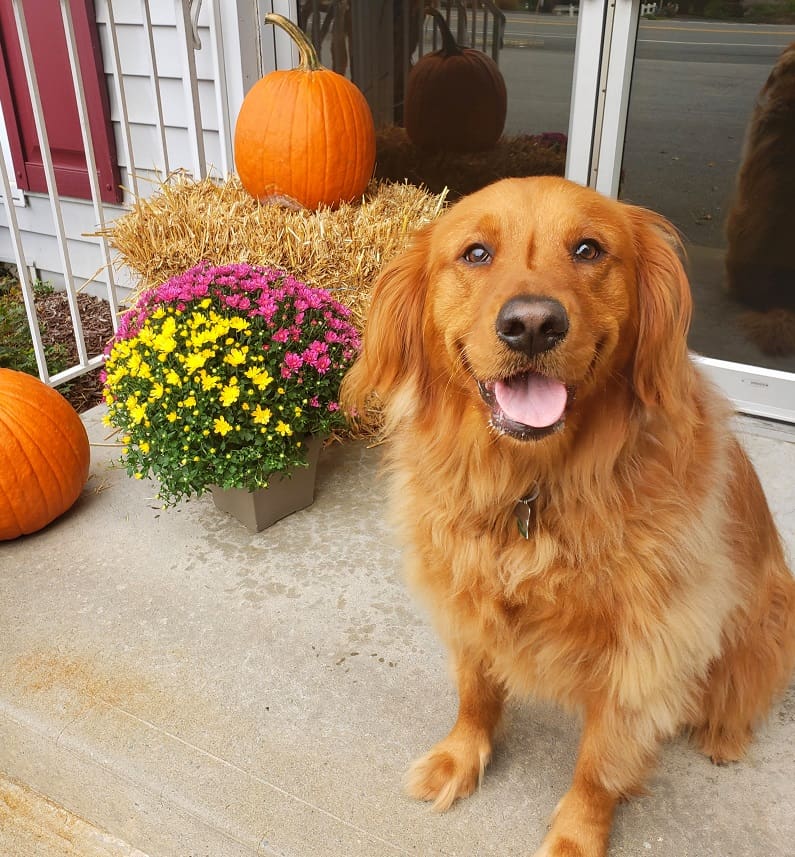This article was written by Jenean McLoskey from Foremost Insurance. The original article can be found here.
When I think of fall, the first images that pop into my head are colorful foliage, apple cider, Halloween, cold weather, and shorter days. While the season is an exciting time for many people across the U.S., it can be a dangerous time for your pets! Between the sudden drop in temperatures, holidays, and the first few months of school, there are plenty of environmental factors to keep in mind when it comes to protecting your furry friends. Here are some seasonally relevant precautions to remember when your pet is playing outside, or simply wandering inside of your house!
- Rodenticides and other poisons.
Small rodents will seek shelter from the colder temperatures, so the use of rodenticides increases during fall months. Unfortunately, they are extremely toxic to pets, and—if ingested—there could be fatal consequences.¹ If you plan to use these products, make sure your pet is unable to access them. This also includes other pesticides and engine coolants. - School supplies.
With school back in session, there are most likely school supplies laying around your home if you have kids. Items like pencils, pens, glue, and pencil sharpeners can be harmful to your dog or cat if they ingest or play with them.² Always make sure to pick up these items around your home! - Toxic mushrooms.
Along with spring, fall is a mushroom season. Although there are a limited number of toxic mushrooms, it’s best to keep your pet away from all types because sometimes it’s hard to distinguish which ones are harmful.² If you believe your pet has ingested a poisonous mushroom, take them to your local veterinarian right away. - Colder weather…darker earlier.
The temperature is often unpredictable in fall. In some areas of the country, it fluctuates day-to-day, so you always need to be prepared. If it’s a colder day, bring your pet inside earlier in the evening so they don’t get too cold, and make sure they have a comfortable environment to sleep in. If you walk your dog regularly in the evening, wear bright colors and get a reflective collar so drivers can see you. - Heating devices.
It’s no secret that your pet loves to get into things they aren’t supposed to. If you’re using an indoor heating device in your home, make sure it is turned off before you leave to avoid it causing an accident or house fires. - Pests and wildlife.
Around this time, snakes are preparing for hibernation. This means they can be more easily agitated, so they may bite if provoked. Make sure you know what types of snakes are lurking around in your area and be extra cautious if they are poisonous. As if snakes weren’t enough, bears are also getting ready for hibernation! As they prepare to put on fat for the winter, you definitely don’t want your pup to encounter them. That’s why it’s important to not let your pets roam too far from your house, especially if you live on a large property that is close to the woods.² - Bonfires.
There’s nothing better than a bonfire in the fall, but it can turn into a dangerous situation if you have a dog or cat. After you get the fire going, close off any fire pits and keep your pet away from the spark zone to ensure you have a relaxing, worry-free night. - Halloween candy.

A popular trick-or-treat candy is chocolate—and though most humans think it’s delicious—it can be extremely toxic for your pets.³ A common candy sweetener called xylitol is another harmful ingredient for pets, so play it safe and keep the candy away.³ Maybe you can make it up to them with appropriate dog or cat treats, instead!
- Lawn and gardening tools.
Fall is also a busy season for doing landscaping and other work on the exterior of your home. When you are done, clean up any tools or garden products you were using to prevent your pet from getting into them. - Fruit pits and berries.
Do you have fruit trees around your home? Be sure to pick up any fallen fruits, fruit pits, seeds, and berries. This includes pits from cherries, plums, peaches, and nectarines because they can cause bowel and intestinal blockage, and also contain cyanide.3
Remember to contact your local veterinarian right away if you believe your pet has ingested something toxic, or call the ASPCA Animal Poison Control Center at 1-888-426-4435. If you have any other helpful tips, feel free to share them in the comments below!
Sources:



